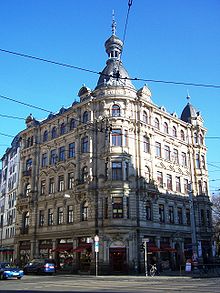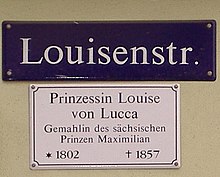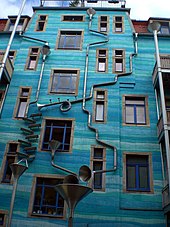Outer new town
|
Äußere Neustadt (Antonstadt) district and statistical district No. 11 of Dresden |
|
|---|---|
| Coordinates | 51 ° 4 ′ 0 ″ N , 13 ° 45 ′ 0 ″ E |
| height | 118 m above sea level NN |
| surface | 1.14 km² |
| Residents | 18,092 (Dec. 31, 2017) |
| Population density | 15,870 inhabitants / km² |
| Incorporation | 1835 |
| Post Code | 01099 |
| prefix | 0351 |
| Website | www.dresden.de |
| Borough | Neustadt |
| Transport links | |
| Federal road |
|
| Train | S1, S2 |
| tram | 3, 6, 7, 8, 11, 13 |
| bus | 64, 81 |
The Äußere Neustadt , also known as Antonstadt (after the Saxon King Anton ), is a district of Dresden and includes that part of the Neustadt that was outside the walls of the former Altendresden (the current Inner Neustadt ). Since the area in which the Antonstadt was founded went undeveloped to Dresden, the Äußere Neustadt belongs to the historic Dresden suburbs . Today, the district is considered to be the trendy district of Dresden.
location
The district is bordered in the south by Bautzner Strasse and Albertplatz , and in the west by Dr.-Friedrich-Wolf-Str./Dammweg (from Schlesischer Platz to Stauffenbergallee ). In the north, the Bischofsweg or the Alaunplatz , often referred to as the Alaunpark , and in the east the Prießnitz border the Äußere Neustadt. However, this is only the official demarcation: For many residents, the district extends to the Hechtviertel , which actually belongs to the Leipzig suburb . Other historical names for the Outer Neustadt are Scheunenhöfe and Auf dem Sande . The Äußere Neustadt is in the Neustadt district .
Neighboring districts
| Albertstadt | ||
| Leipzig suburb |

|
Radeberger Vorstadt |
| Inner New Town |
history
In 1701 the area was released for building, until then there were only a few roads through the former forest area. In 1745 the area was divided into parcels and most of the roads that still exist today were laid out. During this time (1751) what is now the oldest Jewish cemetery in Saxony was laid out.
One of the oldest streets is Louisenstrasse , which crosses Antonstadt to the east-west. In 1797 it is mentioned as a bathing alley, later as a school alley (named after the former school and orphanage in the current number 59). It was named in 1839 after Princess Louise of Lucca , the young wife of the former Crown Prince Maximilian of Saxony .
Little by little the first companies came into being. Among other things, a foundry , a chicory factory and an alum river boiler. Alaunstrasse was named after this. One of the most important companies was founded in 1823 by the businessmen Gottfried Jordan and August Friedrich Timaeus , the Jordan & Timaeus chocolate and chicory factory between today's Timaeusstrasse and Jordanstrasse.
At the end of the 19th century the quarter experienced a real boom, many of the houses that are characteristic of today were built during this time. In the present (also because it was hardly hit during the air raids on Dresden ) it is one of the largest urban areas with closed " Gründerzeit " developments in Germany.
In 1917, the Leowerke , which had emerged from the Leo laboratory of the pharmacist Ottomar von Mayenburg , moved into their premises at Katharinenstrasse 4 to produce Chlorodont toothpaste there. The factory quickly became the headquarters for a company that operates and produces worldwide. The successor company Dental Kosmetik GmbH & Co. KG Dresden is still there today.
The Hannes Kästner Versand (HK Versand), which was founded in 1899 and is probably the most famous mail-order company in the GDR, was located at Louisenstrasse 13. Condoms (brand "Mondos"), hygiene articles and cosmetics were sent discreetly to 30,000 customers.
The district festival Bunte Republik Neustadt has been held annually in the trendy district of Äußere Neustadt since 1990, and with over 100,000 visitors has developed into the largest district festival in East Germany.
All year round, the many painted house facades and the pulsating nightlife testify to the development since the " turning point ".
Attractions
The Martin Luther Church is located on Martin-Luther-Platz . This was built from 1883 to 1887 and is one of the historicist churches in Dresden. Its 81 meter high tower is a striking landmark in the Outer Neustadt.
A 240-meter-deep well was drilled at Albertplatz to supply water to the Outer Neustadt, which reaches water-bearing, taut layers with sufficient water pressure to allow the water to rise. The fountain uses the geographical peculiarity of the lost water , which seeps away in the higher elevations of the north of Dresden. In 1906, Hans Erlwein set up the artesian fountain on Albertplatz on the other side of Königsbrücker Strasse . Since the water has a constant temperature of 13 ° C, the fountain - in contrast to the two main fountains on Albertplatz, "Still Waters" and "Stormy Waves" - is operated all year round.
Pfunds Molkerei , the headquarters of the distributed dairy, is one of Dresden's tourist attractions. The dairy milk shop on Bautzner Strasse is particularly well known . The historicist shop was built in 1891 and the interior was furnished with artistically designed neo-renaissance tiles from Villeroy & Boch .
The Old Jewish Cemetery in Dresden is located on the Pulsnitzer street near the Martin Luther Square. Established in 1751, it is considered the oldest Jewish cemetery in Saxony. Originally located in front of the city gates, the Äußere Neustadt completely enclosed it in the Wilhelminian style. In 1869 the New Jewish Cemetery was laid out in Johannstadt for the Jewish population .
The Kunsthofpassage on Görlitzer Strasse is a complex of houses, the five inner courtyards of which have been artistically designed. The passage contains small shops such as studios and bookstores as well as pubs and cafes. Not far from there is the Thalia , a former theater and now an arthouse cinema. In the parallel Alaunstrasse on the corner of Böhmische Strasse and the “Palast Theater” there was a Dresden cinema from the interwar period .
The Nordbad on Louisenstrasse was opened in 1895. It is the only historical indoor swimming pool in Dresden that is still in operation after being shut down from 1974 to 1992. It has an 8 by 16 meter pool.
Another attraction is the Panama children's farm on Görlitzer Strasse. The Kamenzer Straße cultural mile with its numerous galleries, workshops and the Orpheum ballroom built in 1873 leads directly into the Dresden Heath . There are also many studios, galleries and event locations on Prießnitzstraße. Examples are the Blue Factory founded by Lutz Fleischer , the gallery three of the Dresden Secession 89 and the travesty revue theater Carte Blanche .
Despite or precisely because of the closed Wilhelminian style buildings , which are now under monument protection, more than 250 bars, restaurants, hostels and a few hotels have settled in high density in the Outer Neustadt; the nightlife (without curfew , and since June 2016 with unrestricted alcohol sales again) is one of the liveliest in Germany. The population of the Outer Neustadt was around 11,500 in 1990 and 2000 and rose to 17,300 by 2012, and a further increase of 1,000 is forecast by 2035.
A listed building is, for example, the semi-detached house at Katharinenstrasse 14/16 .
traffic
Two of Dresden's traffic axes run through and on the edge of the Äußere Neustadt. In the south, the district is bounded by Antonstrasse and Bautzner Strasse , which carry through traffic as Bundesstrasse 6 . On the Königsbrücker road to the west of the district which runs Federal Straße 97 . Albertplatz as their intersection is located directly south of the district boundary in the Inner Neustadt. Many side streets in the district form Tempo 30 zones. The most important of these streets are Alaun and Louisenstrasse, where most of the restaurants and shops are located.
The Dresden tram lines 3, 6, 7, 8 and 11 run on the two traffic axes to the Neustädter tram junction at Albertplatz. Line 13 of the Dresdner Verkehrsbetriebe bypasses this and runs between Bischofsplatz and Hoyerswerdaer Straße through the middle of the trendy district. Due to the lack of space, one of the few single-track sections in the Dresden network is located on Görlitzer Straße.
On the western border of the Äußere Neustadt is the Dresden-Neustadt train station , where, in addition to local and long-distance rail traffic, the S1 and S2 S-Bahn lines stop. In addition, the S-Bahn (S1 Meißen-Schöna) stop at Bischofsplatz went into operation in March 2016. Thanks to its connection to line 13 and its location in the Leipzig suburb right on the border with the Äußere Neustadt, it is a quick route to the trendy district enables.
Others
The writer Erich Kästner was born on February 23, 1899 in Neustadt. In his childhood memories, published in 1957, When I Was a Little Boy, Kästner describes his childhood experiences. A memorial plaque has been in memory of Kästner since 1981 on the house where he was born, at Königsbrücker Strasse 66. Later the family moved along Königsbrücker Strasse to 48 and finally to 38. Kästner often visited his uncle Augustin, who owned a villa on Albertplatz, and watched the hustle and bustle on Albertplatz while sitting on the wall. A bronze statue of the writer sits on the wall today, and the Augustin Villa houses the Erich Kästner Museum . Another Kästner monument is on the opposite side of Albertplatz.
literature
- Una Giesecke: The outer new town. From the history of a Dresden district . Sandstein Verlag, Dresden 2007. 2nd edit. u. exp. Edition ISBN 978-3-937602-71-4
See also
- Schauburg , Neustadt cinema steeped in tradition
- High-rise on Albertplatz , the oldest office tower in Dresden (built in 1929)
- Doll Museum Dresden
Individual evidence
- ↑ a b District 11 - Äußere Neustadt (Antonstadt). (PDF; 435 kB) Retrieved May 13, 2014 .
- ↑ http://www.stadtwikidd.de/wiki/Hans_K%C3%A4stner Stadtwiki Dresden on Johannes Georg Kästner
- ↑ Photo of the house facades
- ↑ Merian travel guide Äußere Neustadt
- ↑ Illegal but tolerated pubs existed before autumn 1989; legal from December 1989: “The people of Neustadt called their district the Bronx. Many fled the damp, ramshackle houses ... Those who stayed banded together with defiant pride. Sören Naumann called his 'coffee shop' “Bronxx”. When he opened it in December, it was the first alternative café in Neustadt. In the meantime 'Tivoli', 'Planned Economy', 'Café 100', 'Stillos' and 'Raskolnikov' have followed. ”, Marianne Wellershoff, Johann Grolle: The Dresden of Zombi, Rotze and Zora. In: The time . 41/1990
- ^ Anton Launer: Police Ordinance - Spätshop-Erlass. In: Neustadt whisper. November 14, 2006, accessed May 13, 2014 .
- ↑ Ingof Pleil: alcohol ban lifted for Neustadt. In: Dresdner Latest News . April 15, 2016. Retrieved February 18, 2017 .
Web links
- History of the Outer New Town
- The Dresden Neustadt ("Neustadt whisper")
- The colorful Elbe Republic: Dresden-Neustadt ... "Anyone who says Neustadt in Dresden means the Outer Neustadt."






